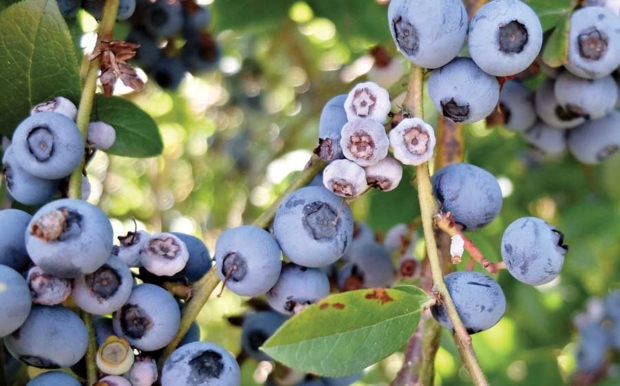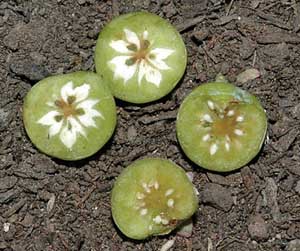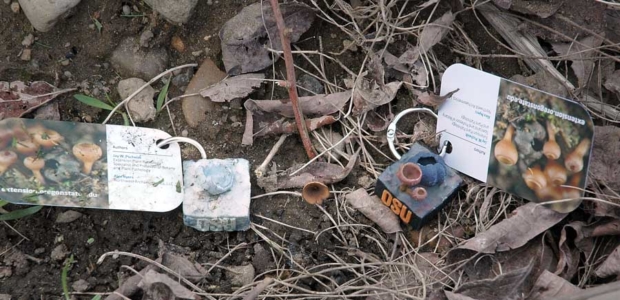
Mummy berry is a disease that suits its name, turning plump blueberries into white, wrinkled berries that fall to the ground and serve as a winter home for the causal pathogen.
In early spring, those mummy berries develop into small mushrooms, called apothecia, which release spores to be spread by wind to infect healthy plants.
It’s one of the most significant diseases of highbush blueberries in the Northwest. There are management options available for both conventional and organic growers, but they have been unable to consistently control the disease.
In Oregon, commercial losses can range from 33 percent to 85 percent, with organic losses routinely reaching near 100 percent of the crop.
Researchers are working to help blueberry growers forecast for and better recognize the signs and symptoms of mummy berry. Those efforts include a particularly novel idea that, if successful, could carry over to help growers recognize other pests and diseases.
Knowing when to spray

Understanding the cycle of the disease is key, researchers say.
Mummy berry has two stages of infection. Primary infections occur when spores infect emerging leaf and flower buds in the spring. These “strikes” first appear as dark brown discoloration of leaves.
Secondary infections occur when spores infect the flowers and fruit from within, which causes the wrinkled, pumpkin-shaped berries that give the disease its name.
Researchers at Washington State University are targeting the first phase of infection in hopes that by improving the timing of fungicide applications, growers can better control subsequent disease development in the field.
“Right now, growers are starting applications around bud break, and then continuing on a calendar schedule,” said Dalphy Harteveld, a postdoctoral research associate at WSU’s Northwestern Washington Research and Extension Center in Mount Vernon, Washington. “We’d like to refine that process, to use fungicides only when they’re needed and actually reduce the amount of fungicide that’s used to control the disease.”
Specifically, Harteveld is working to develop a model that identifies the weather factors that control spore release. With two years of data already gathered, Harteveld plans to collect data again this year to build the model and begin testing it next year.
“In the mummy berry cycle, there are specific susceptible phases when flower clusters and leaf clusters get infected. Initially, I thought that would be about the same time for each, but that’s not the case,” she said. “The timing of the development of these two features may actually affect whether disease develops in those plants.”
There’s a window of time in which the mushrooms produce the spores — about 10 days, maybe two weeks if the conditions are right. But the mushrooms don’t all come up at the same time, so over the spring, growers could have a month or five weeks that spores are coming up and being dispersed.
However, fewer spores are dispersed at the beginning and end of that window, and because different blueberry cultivars develop at different rates, some varieties might not require such intense disease control as others, said Tobin Peever, associate professor of plant pathology at WSU’s Pullman and Mount Vernon campuses.
“The timing of infection is related to bud break, or when vegetative and floral shoots appear, and this varies significantly by cultivar and location,” Peever said. “Because there are large differences in when they first break their buds, growers are going to be able to time their sprays accordingly in a customized way.”
Once the factors tied to spore release are confirmed, Harteveld aims to build a calculator that growers could use to determine when they can expect spores to be released in their area.
In the meantime, she’s been producing weekly mummy berry updates for four cultivars widely planted in two counties in western Washington, which are posted on WSU’s website at http://bit.ly/25I4kEZ.
Spotting ’shrooms

Scouting for the apothecia that emerge under blueberry plants could provide growers time-sensitive information about how best to manage the fungus.
However, the mushrooms are small and blend in easily with the ground, making them difficult to find.
Enter the 3-D printed model of a mushroom.
Jay Pscheidt, professor and Extension plant pathology specialist at Oregon State University, is working to develop an actual-size and color model of the mushroom to help growers identify it in the field.
At only about 1/4-inch wide and a shade of brown that matches the soil, the mushrooms are difficult to spot for the untrained eye, Pscheidt said.
The mummified berries fall off the bush the previous year, often staying in place and emerging as mushrooms in the spring. If there’s a raised berm or hill, they may roll a bit, or they could be covered with leaf material or debris, but the mushrooms work their way out without too much trouble, he said.
“The goal is to educate growers on what it looks like, what to look for, and to get them a little more keyed into what’s going on so they can tighten up their control tactics,” he said.
Pscheidt worked with OSU’s Department of Archaeology to quickly scan into the computer real mushrooms from different positions before they began to dehydrate and lose color. From those scans, a model of the mushroom was born and printed on a 3-D printer.
Pscheidt handed out the first samples to field representatives and county agents for evaluation. Though the color washed out when it got wet and the printed material wasn’t as strong as he would like, Pscheidt said the model shows promise. He’s looking into a different service that could print them on stronger, more durable materials for long-term use.
“We track when these mushrooms come out and how long they stay out. In some years, it’s as short as eight days, and in other years, it’s as long as four weeks,” he said. “It’s variable over the years, and that’s what makes it very hard to get after.”
Ultimately, if the 3-D model proves successful, Pscheidt said he sees potential for the technology to be applied in other areas, namely, identifying brown marmorated stink bug.
“BMSB — there is an identification that might lend itself to 3-D printing,” he said. •
—by Shannon Dininny






You don’t say how to control it.
Could a thick mulch be replaced by some kind of ground cover that allows water to pass but not the mushroom spores?
same as Dave said what can be used on it, any recommended fungicide?
What kind of fungus side can I use on the blueberry bushes I can’t seem to find an answer to that question
Fighting mummy berry with fungicides remains a challenge. We aren’t able to make any product recommendations, but here’s our latest update on managing mummy berry: https://www.goodfruit.com/bee-based-biocontrol-video/